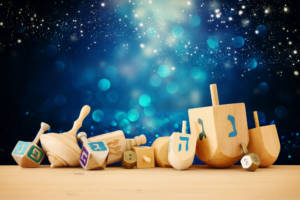Dreidel, Dreidel, Dreidel: The History and Legends Behind a Hanukkah Pastime

The dreidel comes in many different forms and sizes. Alongside the menorah, this spinning top game is one of the most recognizable Hanukkah traditions.
Spinning the dreidel is a popular game during Hanukkah. Alongside the menorah, this spinning top game is one of the most recognizable Hanukkah traditions. It’s such an integral and memorable custom that some who play with dreidels as kids go on to collect them as adults. Where did this little top come from, and how did it become part of Hanukkah celebrations? The answers to these questions may surprise you.
What Is a Dreidel?
Dreidels come in many different forms and sizes. Chabad explains that most are square or rectangular with four sides and a pointed base. They’re usually made of plastic or wood, but collectible versions can be crafted from silver, bronze, ceramics, glass, crystal, brass, or pewter.
Every dreidel is decorated with four Hebrew letters. However, there are slight differences between those used in Israel and those on dreidels made in other parts of the world. The iCenter for Israel Education clarifies that Israeli dreidels bear the letters nun, gimmel, hay, and pey. These letters stand for “nes gadol hayah po,” which means “a great miracle happened here.” Dreidels outside of Israel are decorated with different letters: nun, gimmel, hay, and shin. These letters stand for “nes gadol hayah sham,” translating as “a great miracle happened there.”
Legends of the Dreidel’s Origins
Chabad retells one common tale that explains the dreidel’s invention. During the middle of the 2nd century B.C.E., Judea was part of the Seleucid Empire ruled by Antiochus IV Epiphanes. Shortly before the Maccabean revolt, the king had outlawed all Jewish religious practices. Learning the Torah had become a crime punishable by death, Jewish children continued to study it while hiding in caves. When Greek patrols approached, the children would put away their Torah scrolls and play with their spinning tops instead.
Rabbi David Golinkin discusses other explanations for the dreidel’s origins. These include detailed numerological backstories for the four Hebrew letters on the dreidel. Others involved wordplay, and a few insist that they stand for the four classic empires that oppressed the Jewish people: Babylon, Persia, Greece, and Rome.
Did the Dreidel Come From Ireland?
During the early 1500s, English and Irish children played a spinning top gambling game called “totum.” By the 1700s, it was a Christmas pastime called “teetotum.” The Irish version used a four-sided top with four words: “take all,” “half,” “put down,” and “nothing.” Each player would follow the directions based on how the top landed. Winners took all or half of the pot. “Put down” directed the player to add to the pot. “Nothing” required no action.
Rabbi Golinkin adds that this game made its way to Germany, where the top was decorated with the letters n, g, h, and s. Jewish children eventually learned the game, and Hebrew characters replaced the Roman letters on the top.
Two Names, One Object
Where did the word “dreidel” originate? Merriam-Webster Dictionary explains that it comes from the Yiddish word “dreydl,” derived from the Yiddish verb “dreyen,” which means “to turn.” Yiddish is a fusion of High German and Hebrew, and “dreyen” comes from an older German verb “drǣjen.”
Some people call this top a “sevivon,” a modern Hebrew word taken from the verb “saváv,” meaning “to turn.” The term may have been coined in 1887 by Itamar Ben-Avi, the son of lexicographer Eliezer Ben Yehuda and the first native speaker of modern Hebrew. Israel 21c’s Rachel Neiman mentions that its first printed appearance dates to 1897, with journalist David Isaiah Silberbusch claiming credit for its invention.
More Than Just a Game
Humans have played with spinning tops for thousands of years. In some cultures, these ordinary objects take on deeper meanings. Regardless of the dreidel’s origin, it speaks to joyful celebrations and the strength of the human spirit.

